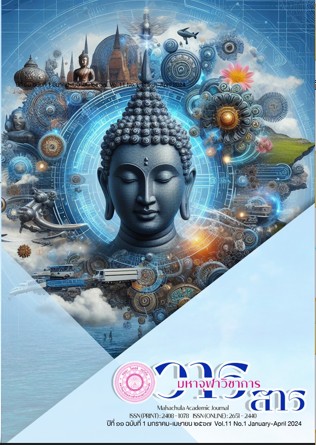Guideline on Requesting the use of Ratchaphatsadu land for Promoting Buddhism
Main Article Content
Abstract
This research has three objectives: (1) To study the affairs of the Sangha in land utilization. (2) To study the management Ratchaphatsadu land and how to apply for use of Ratchaphatsadu land, and (3) To propose guidelines for applying for use of Ratchaphatsadu land for promoting Buddhism. It is a qualitative research. By studying documents and in-depth interviews with key informants 9 person.
From this research, it was found that Sangha affairs in land utilization are land utilization according to public utility tasks that must be considered in 3 aspects: (1) Legal compliance. (2) Land allocation, and (3) Area management. In addition, worthiness of land use must be considered based on 5 factors: (1) Opportunity and suitability according to the development potential of the temple. (2) Sangha leadership potential. (3) Construction control. (4) Responding to utilization for Sangha affairs, and (5) The response to the utilization for the community. Management of Ratchaphatsadu land and methods for requesting use of Ratchaphatsadu land for promoting Buddhism must comply with the laws and regulations set by the government according to the method of applying for the use of Ratchaphatsadu land for promoting Buddhism. There are 3 steps: (1) Submission of documents. (2) Consideration, and (3) Management after obtaining permission. The guidelines for applying for the use of Ratchaphatsadu land for promoting Buddhism consisted of 9 steps: (1) A layman or a local leader prepares documents to apply for the use of the Ratchaphatsadu land. (2) The National Buddhism Office prepares all documents and evidence to be submitted to the Treasury Department.(3) The Provincial Governor gives opinions and submits to the Treasury Department. (4) The Treasury Department. Consider and notify the results and submit relevant documents. (5) The Treasury Office in the area notifies the result of the consideration and submits relevant documents. (6) The applicant for using the Ratchaphatsadu land proceeds to sign the document or notify the discussion to review the result of consideration. (7) The Treasury Department delivers a letter of permission to use the Ratchaphatsadu land. (8) The applicant informs the Sangha to proceed according to the objectives, and (9) The Sangha used the Ratchaphatsadu land according to their objectives.
Article Details

This work is licensed under a Creative Commons Attribution-NonCommercial-NoDerivatives 4.0 International License.
References
การกำหนดเกณฑ์มาตรฐานการใช้ที่ราชพัสดุ. คำสั่งกรมธนารักษ์ ที่ ๓๖๗/๒๕๖๔. (๓ สิงหาคม ๒๕๖๔). (อัดสำเนา).
การขอใช้ที่ดินราชพัสดุเพื่อสร้างวัด. หนังสือกรมศาสนา ที่ ศธ ๐๓๐๓/๖๔๐. (๒๒ มกราคม ๒๕๔๒). (อัดสำเนา).
กฎกระทรวงการใช้ที่ราชพัสดุ พ.ศ.๒๕๖๓. ราชกิจจานุเบกษา ๑๓๗. (ธันวาคม พ.ศ. ๒๕๖๓). (อัดสำเนา).
กฎมหาเถรสมาคม ฉบับที่ ๒๓ (พ.ศ.๒๔๔๑) ว่าด้วยระเบียบการปกครองคณะสงฆ์. กฎมหาเถรสมาคม (ตุลาคม พ.ศ. ๒๕๔๑). (อัดสำเนา).
คณะรัฐมนตรี มีมติรับทราบผลการพิจารณาหรือผลการดำเนินการปฏิรูปกิจการพระพุทธศาสนาของสำนักงานพระพุทธศาสนาแห่งชาติ. มติมหาเถรสมาคม ๑๘/๒๕๕๘. (กรกฎาคม พ.ศ. ๒๕๕๘). (อัดสำเนา).
พระราชบัญญัติคณะสงฆ์ พ.ศ.๒๕๐๕. ราชกิจจานุเบกษา ๑๐๙. (ธันวาคม พ.ศ. ๒๕๐๕). (อัดสำเนา).
พระราชบัญญัติที่ราชพัสดุ พ.ศ. ๒๕๖๒. ราชกิจจานุเบกษา ๑๓๖. (มีนาคม พ.ศ. ๒๕๖๒). (อัดสำเนา).
รัฐธรรมนูญแห่งราชอาณาจักรไทย พ.ศ.๒๕๖๐. ราชกิจจานุเบกษา ๑๓๔ (เมษายน ๒๕๖๐). (อัดสำเนา).
พระราชวรเมธี, ดร. และคณะ, แผนยุทธศาสตร์การปฏิรูปกิจการพระพุทธศาสนา ๒๕๖๐-๒๕๖๔“การนำนโยบายสู่การปฏิบัติ”. [ออนไลน์]. แหล่งที่มา: http://www.buddhism4.com/ web/download /book%201. [๒๕ พฤศจิกายน ๒๕๖๔].
สำนักงานสถิตแห่งชาติ. จำนวนศาสนิกชน จำแนกตามศาสนา พ.ศ. ๒๕๕๑ ๒๕๕๔ ๒๕๕๗ และ ๒๕๖๑. [ออนไลน์]. แหล่งที่มา: http://statbbi.nso.go.th/staticreport/page/sector /th/04.aspx. [๒๕ พฤศจิกายน ๒๕๖๔].


